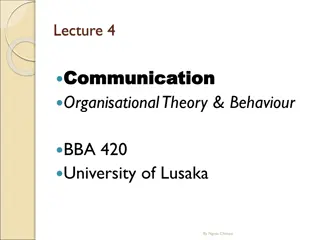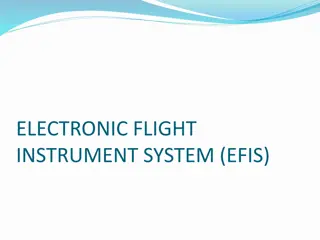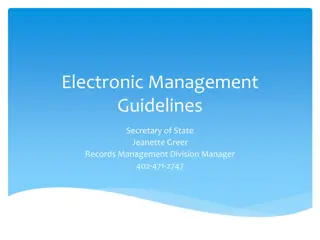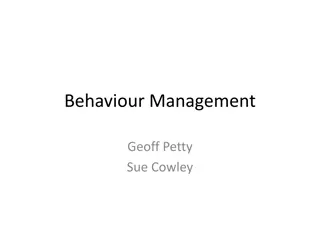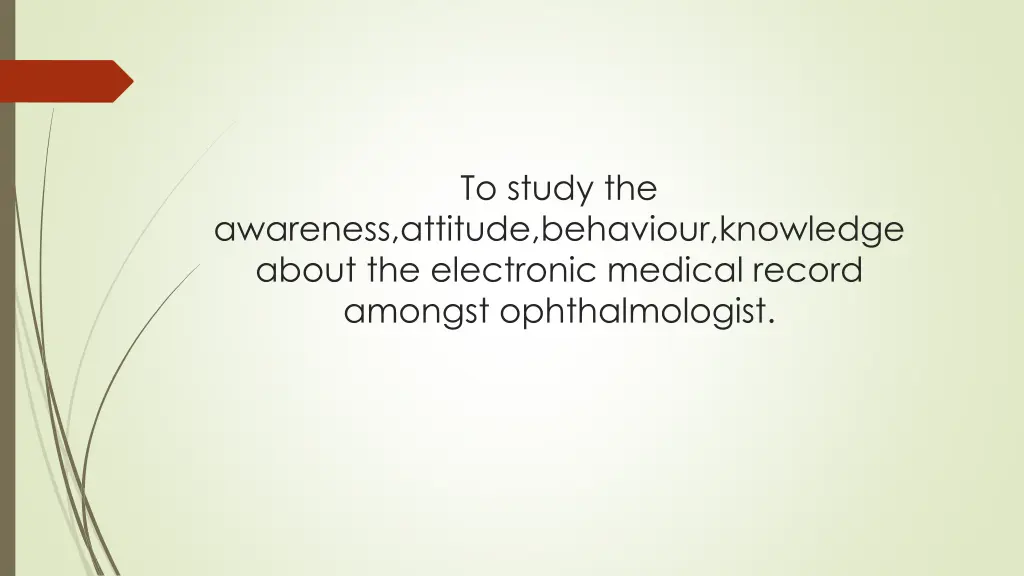
Exploring Electronic Medical Records in Ophthalmology
Dive into the awareness, attitude, behavior, and knowledge about electronic medical records among ophthalmologists. Understand the significance of EHR systems in enhancing eye care delivery and learn about the impact of technology on the healthcare industry. Discover the benefits of EMRs in improving clinical workflow, record documentation, and interdepartmental interoperability.
Download Presentation

Please find below an Image/Link to download the presentation.
The content on the website is provided AS IS for your information and personal use only. It may not be sold, licensed, or shared on other websites without obtaining consent from the author. If you encounter any issues during the download, it is possible that the publisher has removed the file from their server.
You are allowed to download the files provided on this website for personal or commercial use, subject to the condition that they are used lawfully. All files are the property of their respective owners.
The content on the website is provided AS IS for your information and personal use only. It may not be sold, licensed, or shared on other websites without obtaining consent from the author.
E N D
Presentation Transcript
To study the awareness,attitude,behaviour,knowledge about the electronic medical record amongst ophthalmologist.
Submitted by: Kirti Thakur PG/014/26
Organization profile Eli India is part ELI Global-a globally diversified information and financial services group founded in 1991.Today ELI have more than 40 business units in diverse verticals across three continents. ELI s one of the business unit is MDoffice and they have Electronic Health Record (EHR),Practice Management, Revenue Cycle Management and Patient Engagement product which empower and enables ophthalmologist practices to provide effective and integrated care delivery
Internship report The internship was from 1stFebruary 2016 to 30thApril 2016. During this internship period I was involved in various activities like : Giving support to the queries raised by the clients if they have any issue handling with the software Part of the product enhancement team Prepared Visio diagrams on the various eye diseases Learned about CDSS, HL- 7 Integration. Market research on predictive analysis and its use in ophthalmology software. System Design Specification with the data fields & characteristics were documented.
PROJECT OVERVIEW The Indian healthcare industry is seen to be growing at a rapid pace and is expected to become a US$280 billion industry by 2020. According to the investment commission of India; Healthcare sector has experienced phenomenal growth of 12 % per annum in the last four years. Rising income level and growing elderly population are all factors that are driving this growth. Paper-based records have been in existence for centuries and their gradual replacement by computer-based records has been slowly undertaken. Information Technology has not achieved the same degree of penetration in healthcare as that seen in other sectors such as Finance, Transport, Banking and the Manufacturing and Retail Sectors. Also the deployment varies greatly from country to country and from specialty to specialty. It is essential for the ophthalmology fraternity to be a computer literate. The role of information technologies-including use of electronic medical records, retrieving computer-based knowledge resources, and understanding the basics of the Internet-is crucial for physicians.
Electronic health records in ophthalmology should accommodate special needs and requirements of ophthalmologists work flow and practice patterns to facilitate efficient delivery of quality eye care. Electronic health records (EHRs) have the potential to apply these same technologies toward improving the delivery, quality, and efficiency of health care. EMR in the practice will improve the clinical workflow, documentation of the records, interoperability with other departments and many more.
Problem Despite these trends, EHR adoption by ophthalmologists, and by other physicians has been slow. The basic of the study is to find out the awareness,knowledge,behavior and attitude of electronic medical record amongst the ophthalmologist. In order to achieve nationwide interoperability and realize the benefits that EHRs can provide, physician adoption rates must be increased substantially. An understanding of the factors associated with physicians acceptance will allow organizations to better assess system readiness and facilitate successful implementation The barriers of EMR adoption in India.
Objective General objective: To Study the Basic Awareness amongst Practicing Ophthalmologist. Specific objective: To study the current practices followed amongst Practicing Ophthalmologist. To study the Knowledge, Behavior & Attitude towards EMR amongst Practicing Ophthalmologist. To study the perception of the doctors for the digital records and their benefits
Methodology Study design: Analytical study Sampling method: Convenience random sampling Sample size: 50 Sampling area: Delhi &NCR region Data Collection A self-structured questionnaire was drafted & the primary data was gathered by sending the questionnaire through e-mail & also by direct interviews.
Limitations of Study: Gathering response from a large number of ophthalmologist under time constraints was difficult. Therefore, small sample size was one of the limitations for this study. Involving ophthalmologist from all the age group would have given a clearer picture & accurate analysis. But, this was not possible due to time constraints. Involving ophthalmologist from other parts of the country would have given a more meaningful and accurate analysis. But, this was not possible due to time constraints. This was another limitation of this study
The questionnaire was prepared on the basis of the knowledge about emr. computer literacy. use of it applications in the in the current practices Attitude towards EMR adoption.
Have you heard about Clinic/Hospital Management Software?
Appointments & Scheduling done manually?
Expectations form the electronic medical record? 70% of the doctors want the Emr should be customized according to their needs so that adoption will be easy and smooth without any delay. Also ophthalmology is the field where the doctor does lot of drawing so it will be wonderful if emr is incorporated with drawing fields.
Conclusion This study also shows that despite of having good attitude towards the use of IT applications, amongst the young ophthalmologist the knowledge of this group was inadequate & no practice was followed for the use of IT in Clinical Practice. The reason for this is mainly because: - Newer technologies are coming into play, & the young generation easily gets adapted to these technologies. There is lack of awareness. Despite of the adoption of EMRs, in various healthcare facilities, it is still not a part of the formal education. Stressful & traditional practices, leaves no time for exploring the various advancements happening in the field of healthcare. The elder generation, despite of having good knowledge about the IT applications in Clinical Practice, including the EMRs, do not get adapted to the system is because of the following reasons: - Reluctance to change No proper formal education or training is provided.
Recommendations Instead of designing a standard system for all, the need of the end users should be identified and the EMRs should be customized as per their needs and requirements. Proper formal training should be given to both the students & educators. Introduce short refresher courses in computer applications & awareness about the IT applications used in Clinical Practice. The government should introduce certain incentives for implementing the Electronic Medical Records in their clinical practice. Instead of mandating the use of EMR, the ophthalmologist perception about EMR should be understood first. This will allow for the development of targeted education to demonstrate the advantage of EMRs and to further improve their perception. This will lead to widespread adoption and successful implementation of EMRs.
References http://www.sciencedirect.com/science/article http://www.ncbi.nlm.nih.gov/ http://v2020eresource.org/ http://ophthalmologytimes.modernmedicine.com/ http://www.aao.org/ http://www.sciencedirect.com/science/article/pii/S1532046411001262


